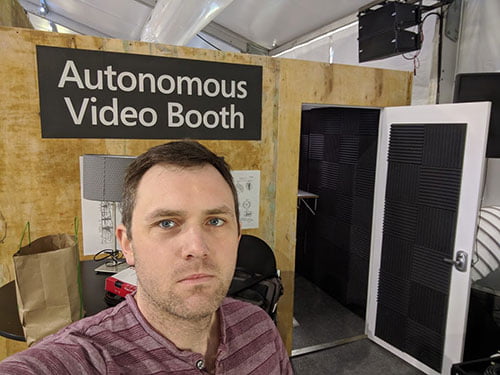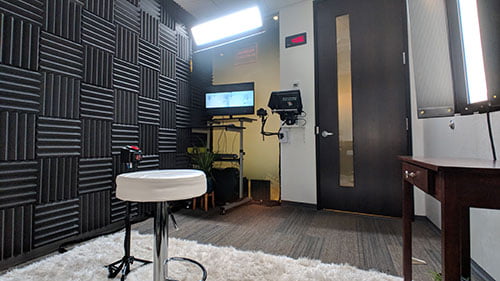Last updated on June 15th, 2024
Video marketing is essential in today’s world. But the tech side of it can be overwhelming, even if you’re tech-savvy in other areas. This is just the problem solved by the Microsoft Autonomous Video Booth, where Microsoft employees walk into the studio, click a button, and it just starts working. Zero setup time messing with lighting, cameras, teleprompters, or audio. The inventor of the project, David Kahler, tells us how this all works.
GUEST: David Kahler from Microsoft. Connect with David on LinkedIn.
HOST: The VidAction Podcast is hosted by Dane Golden of VidAction | LinkedIn | | YouTube
SPONSORS: This episode is brought to you by our affiliate partners, including: TubeBuddy, VidIQ, MorningFame, Rev.com, and other products and services we recommend.
TRANSCRIPT
Dane Golden:
It’s time for the VidAction Podcast. This is the podcast where we help marketers just like you get more value out of your video marketing efforts. My name is Dane Golden from VidAction.tv and VidTarget.io. And today we have a special guest, the Microsoft Autonomous Video Booth creator, David Kahler, or is it caller Kaler, Kahler?
David Kahler:
It is Kahler.
Dane Golden:
Kahler. Welcome, David.
David Kahler:
Yeah, thanks for having me. I’m excited.
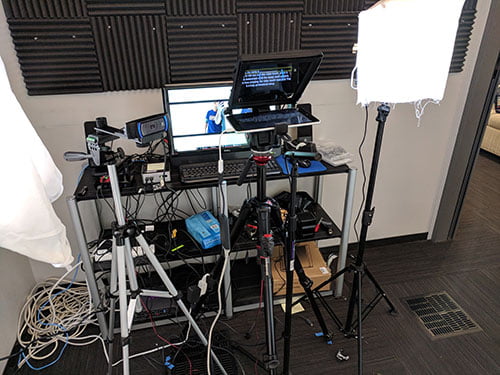
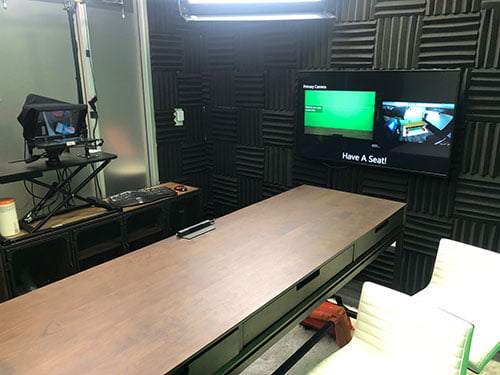
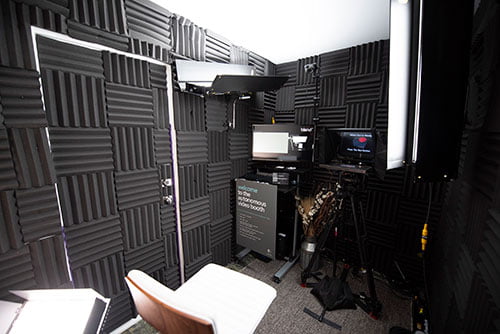
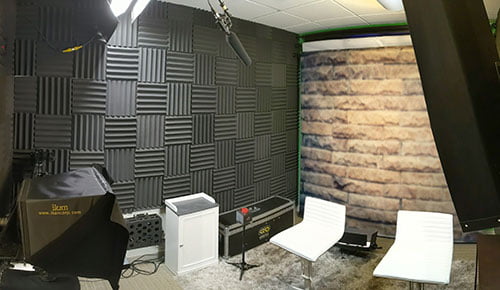
Dane Golden:
I’m excited too. David, we asked you on today because we recently interviewed in a previous podcast, Sonia Atchison from Microsoft, who talked about how Microsoft is using YouTube for product support and connecting with influencers. But she told us a secret. She told us she was calling from something called the Microsoft Autonomous Video Booth and I just had to find out what that was. And apparently you’re the inventor.
David Kahler:
Yeah, that’s me. Basically what the Autonomous Video Booth is, is it is the fastest, easiest way to create high-quality talking head videos. So a couple years ago we had a hackathon and we decided to just throw this together in an office space. And really what it is, is it’s a automated video production studio. So we have nice lights, we have nice microphone, a couple different camera angles. It kind of greets you when you walk in and it leads you through the process and we’ve distilled the creation of high-quality videos down to the press of a single button –
Dane Golden:
Let me get you to stop there for a moment and tell me what you mean by it greets you.
David Kahler:
Yeah, this is actually one of the most popular features of it. Not the video creation or anything like that, but it kind of plays this sort of spaceship sound and it says, “Welcome to the video booth,” when you come in because there’s a motion sensor in it, it turns on the lights and gets ready for you. So yeah.
Dane Golden:
And it’s a voice emitting from a computer. It’s a voice emitting from a different device.
David Kahler:
Yeah. It’s just running on a PC. It’s just a regular PC app that’s hooked into some motion sensors. So it knows when you come in. And so we have speakers, so it’s just coming through the speakers.
Dane Golden:
Okay. So I come in and give me a feeling of what… You said it’s just a converted office room, but give me a feeling as to what it looks like. How big is it? What’s on the walls? What’s in it?
David Kahler:
Yeah. The space is usually something like eight by 10 feet. The walls are covered with just kind of regular sound treatment foam just to reduce the echo in the room. There’s an instructional poster on the inside that tells you what to do. There’s a piece of furniture at the front of it that has all of our cameras. The mic comes down from the ceiling. And then there’s also, depending on the room, we have several of them, but some of them have a variable backdrop system. So you can use these motor roller systems to change out your backdrop.
Dane Golden:
Okay. And that leads me to other questions such as when you say it’s usually, do you mean there is more than one?
David Kahler:
Yeah. Right now we have three in Redmond, one in Bellevue, one in Vancouver, and then we have a few more that are kind of on the way.
Dane Golden:
Okay. For our listeners, these things will be important. Could you talk about some of the details like what kind of camera, lighting, and microphones you’re using?
David Kahler:
Sure. Yeah. We are using a Sony cameras, either the a6300 or 6400, mainly because Sony has really awesome continuous eye-tracking autofocus, which is really important when we don’t have anyone behind the camera to autofocus for us. The mic we’re using is a Sennheiser shotgun mic. I think it’s like MKH-416, something like that. It’s a really nice mic. Feeds into a Focusrite Scarlett audio interface.
David Kahler:
And then the lights are Kino Flos. That’s kind of our big splurge. Very, very expensive lights, but give us a ton of control over output and color, temperature, and really let us dial in. Because a lot of people who are coming into this thing, really the most people that are coming into it are not comfortable on camera. So if we can make them look really good when they sit down, then that really helps put them at ease.
Dane Golden:
How do they know they’re looking good when they sit down?
David Kahler:
Yeah. There’s a monitor that’s just right next to the cameras in the front there. And so it shows a preview of both of the cameras, which also has some guides on it to try to get them to frame themselves up properly. Put the stool at the right height so that they look right on camera.
Dane Golden:
How do you get them to look at the camera?
David Kahler:
There’s two screens. We have a teleprompter on the primary camera and then the secondary camera is just sort of a side angle. So all of the UI that you read and follow is actually displayed on the teleprompter.
Dane Golden:
Wow.
David Kahler:
So, just when you’re starting getting going, you’re getting a noose to the idea of looking that way. Some people actually don’t even realize that there’s a camera behind the teleprompter, they’re just looking at the screen. So it works out naturally. And then you can push scripts to the teleprompter with a really easy website that you just put your … into it and it automatically pulls it down. And then you can either put a script or a PowerPoint deck on there and just talk to it. And so when you’re talking to that guy, you’re actually looking straight at the camera, which really helps with viewer engagement.
Dane Golden:
And when you’re looking at this teleprompter, is it like a eight by 10 type of teleprompter or much larger?
David Kahler:
It varies a little bit depending on the installation. We started with a super small kind of tablet teleprompter. You just throw like a Surface Pro in there or something like that. Or you can even put a phone in there. We’ve since switched over to one that has a built-in screen that’s I think around 17 inches. So that’s much nicer. Really the bigger it is, the easier it is to read. But also the bigger it is, the more expensive it is. So it’s a trade off.
Dane Golden:
And does anyone do this, for instance, let’s say they’re interviewed for a video. Do they see the other person?
David Kahler:
Yeah. Right now it’s mostly set up… Well, most of them are set up for single person. Sometimes we can get two people into the shot, but it’s not really the most natural interview style setting. Actually the next one that we’re building is going to be three cameras so that we have-
Dane Golden:
Oh, wow.
David Kahler:
… two seats with one camera pointing at each seat and then a third camera that’s the wide angle of the two people, because interview style is by far one of our biggest requests.
Dane Golden:
Do you mean a two shot of two people side by side?
David Kahler:
Yeah. They would basically be side by side, but they would each have their own camera.
Dane Golden:
I see.
David Kahler:
So we’re not trying to like shove them into one frame.
Dane Golden:
I see. I’m sorry. Did you say what types of teleprompter set ups you’re using? I think our listeners would like to know.
David Kahler:
All the teleprompters we’re using now, I think it’s called Ikon or Ikan, I-K-A-N. So they have a couple different kinds. They have a tablet style one that we have in a couple of our installations that holds like up to 13 inch and we actually use a monitor these days instead of a tablet. That one’s like a $700 one and then you can bump up to like a 17-inch fixed monitor one. But that takes you up to like two grand.
Dane Golden:
Okay. I assume that when someone at the company wants to use it, they reserve it and then maybe they pre-fill I guess their script into the website beforehand. Is that how they do it?
David Kahler:
Right. Yeah. They can use it first come first serve. It is reservable as a conference room. So it’s kind of standard conference room etiquette. If someone has it reserved and you’re in there, then they can kick you out. But yeah, there’s a just very, very simple website that you go to ahead of time and you just manually plug in your alias and paste in your script or upload your PowerPoint deck that goes to an internal server. And so then when you come into the room, there’s a badge reader that you swipe your badge at so then it knows who you are and it pulls down what you had uploaded.
Dane Golden:
And let me ask this question. When you say there’s a PowerPoint uploaded, does that mean that you are also recording the PowerPoint in a way of a tutorial or a webinar at the same time? Maybe there’s two pieces to be edited from and two or something like that. Is that what I’m hearing or is it you just read from it?
David Kahler:
Yeah. It’s kind of a cool feature really. It’s evolved over time. Originally it was just you could upload a deck and just have something to talk to so you could use it as your notes. Just some people are more comfortable talking to a deck rather than a scrolling script, but more recently it now actually sends the deck to the server and process it in a way. So we have a simple web editor that’s kind of the end of this process that lets you change between your camera angles and add overlays and that sort of thing. But the cool thing is that the web editor can also now pull in the PowerPoint and it’ll actually record or it’ll keep track of when you switch each slide. So it’ll automatically populate overlays in your edit based on when you switch to each slide.
Dane Golden:
So it’s all autonomous except of course that somebody will have to edit something or it is not really?
David Kahler:
Yeah. Some people just use… Like we do kick out just the individual camera views on their own. So a lot of people will just like take the front camera view if they’re just trying to convey a simple message and just post that straight up to stream or wherever. But the editor is super simple, like two minute process and then you can get an edit out where you can switch between the different angles and add some stuff. That adds a little bit of extra work, but it’s really very, very quick.
Dane Golden:
Can I ask which editor it is or is it custom or?
David Kahler:
Yeah, this is a custom web editor. It’s based on the idea of a live recording. So like you’re the director watching someone recording something live and you’re saying like, “Go to camera two. Now go the overlay about…” Whatever. And so you just watch it once and you click on some stuff and that and that’s the end. Then it spits out your edit
Dane Golden:
And then I assume there’s some sort of server that this is hosted on that someone can access and work with later as they wish.
David Kahler:
Right. Yeah. It’s just hosted on a virtual machine that’s in Azure, that’s kind of behind our Corpnet firewall. So it’s not something that is publicly available. It may be at some point, but-
Dane Golden:
Well, it sounds like none of this is… I’ve seen no photos of this, no video. This is top secret.
David Kahler:
No, it’s not top secret, it’s sort of just getting legs really. There is one LinkedIn video. We had a LinkedIn influencer, I believe, named Goldie who-
Dane Golden:
Goldie Chan.
David Kahler:
Yeah. Who came and did a tour of campus and also got a quick tour of one of the Autonomous Video Booths at the garage installation. So I can point you to that at least.
Dane Golden:
Please. Yeah, hopefully we’ll have that and put that in the show notes.
Dane Golden:
Let’s talk about what this solves and why this is so helpful. What kinds of problems were people having that caused you to want to have this?
David Kahler:
There’s a couple things really. One is that people are still, especially in enterprise, people who are not used to making videos, they’re still very intimidated by it. And so anything we can do to encourage them to make more videos to more effectively communicate their message and make them more comfortable with the whole process, that’s really what we’re striving for here.
Dane Golden:
Yeah. I would just assume it just takes too much time. They don’t know what it’s like to be on camera. If they need a video, I’m sure that there’s amount of time they have to deal with, with learning to edit and making sure the sound is right. Doing all that stuff independently when it should be just the return key.
David Kahler:
Yeah. The other thing that I was going to say is that we would often have meetings where we basically just show videos back to back that people have made. And the quality between the videos is just so wildly different that it almost becomes impossible to watch them. Like the audio levels keep changing and you have to keep fiddling with them. And so if we can provide this consistent experience, then even consuming the videos is much more pleasant for the audience.
Dane Golden:
That’s great. That’s great. And so here’s the next question. How have people messed it up that you had to fix? What did they do wrong that you had to make it foolproof?
David Kahler:
The secret here is that it is not 100% autonomous. I would say it’s like 95. We improve it all the time. But yeah, so some common things that happen, people might bump a camera so the framing gets off that someone needs to come in and fix it. The more significant things people have done is like either bring furniture into or out of the room and so then that makes it difficult for the next person to use it. Or something breaks, someone doesn’t tell us. Like sometimes the backdrop system, something might break on that and we have to fiddle with it to play with it. And then we just get a note from the next person who wasn’t able to use it. Luckily though, those things happen pretty rarely these days. I would say the uptime is we have like maybe one problem every month or two or something like that. Yeah, I can’t say that’s how it always was, but it’s gotten pretty good these days.
Dane Golden:
When was the origin? When did you start doing this?
David Kahler:
The original hackathon was in late 2017. And then we kind of just left it running and started doing some demos to people without really planning on doing much with it. But people were just so enthusiastic about the whole thing that it just kept us going and became its own beast.
Dane Golden:
Yeah. Let’s talk about the response from all over the organization. What have people said?
David Kahler:
We definitely have sort of a set of fans. We have a team’s channel of 40 or 50 people now, who just love it and use it for all sorts of things. It gets used a lot for just informational purposes. People doing tutorials and introductions to their team or just lighthearted stuff. We’ve had CVPs do Christmas messages on it. I’ve had people bring in their kids and dogs and so all sorts of things get done on it. And really, yeah, I think it helps drive that or at least the feeling of the culture of innovation and the growth hacking and growth mindset across Microsoft. It really helps people come into work and think that they’re working for a really cool company and that they’re excited to be there. So there’s a big cultural component to it.
Dane Golden:
That’s great. What would you say is maybe the most surprising use that you’ve seen come out of that?
David Kahler:
I have had, I think two people now in the history make music videos with it.
Dane Golden:
Oh cool. Cool.
David Kahler:
Yeah. So like bring in a guitar or something like that and just do their thing. Yeah.
Dane Golden:
As video becomes more and more, how do you see tools like this evolving across all of American or international industry? Do you feel that you’ll see more things like this? You’re at the forefront, but do you think you’ll see a lot more of that?
David Kahler:
That’s my hope, yeah. What we’ve really discovered with this is that it’s all about the end-to-end experience when you’re creating and editing and publishing video. And while there’s a lot of great tools for doing each step of that process, especially for people who aren’t super technically inclined, it’s really hard to discover the right workflow for doing it all at once. So really what we’re trying to push here is a super tight integrated workflow for people to create and publish video.
David Kahler:
And so for this project in particular, I think kind of keeping those things tightly coupled and helping people, especially enterprise partners, set up their own hardware and get our software on there. And make it so it truly is as easy as pushing a button is what this project in particular. I think that’s the direction it’s going. But as far as the cultural side of things, I really think that we need to push on just getting our software more integrated to all devices and all platforms and just making videos super, super easy.
Dane Golden:
Right. You’re working with some of the smartest people around there at Microsoft. Very technical people, except they’re not video experts.
David Kahler:
Exactly. Yeah, we have obviously a bunch of teams that are video experts, but most of the people at Microsoft are not. But we’re really pushing these days video as a first-class citizen and video as a document. And so we’re trying very rapidly to figure out how to get people on board with just making videos for basically every part of their job.
Dane Golden:
Now, a lot of people are dealing with working from home right now and so they probably can’t go into the studio as much. Can you think of any implications of what you’ve learned about this or for people who are maybe setting up their own studios at home or is there any application that people can use remotely? Can they record into this from home yet or anything like that?
David Kahler:
I mean, the app can certainly run on any PC though it is sort of like game console software in that it expects or works best with very, very specific set of hardware. That doesn’t necessarily mean it has to. That’s just the way it is right now. So yeah, we’ve kind of dabbled with the idea for a long time of sort of like a video booth in a box or sort of giving people guidance on what hardware to buy and how to set it up. And then maybe if you install our software with that, then we can give you a nice workflow all the way through. Make it super easy to post the stream or YouTube or whatever you want to do. But yeah, that’s sort of still pie in the sky right now.
Dane Golden:
Right, right. Well, David Kahler, this has been very interesting. I think that our listeners will be very interested to find out about this because video is taking over business and this Microsoft Autonomous Video Booth is really the way I think a lot of things are going to go and we’re all going to have to adapt based on your model or something similar to it. Could you give us some more links? I know we’ll put that LinkedIn video in there or any other things you’re working on.
David Kahler:
Yeah, sure. I can give you some photos of the booth and I’ll dig up a video or two that should be public. And yeah, if people want to reach out to me on LinkedIn or whatever, we’re looking for enthusiastic enterprise partners to help us figure out what an external version of this might look like. So I love to talk to people.
Dane Golden:
Oh, that would be great. Yeah, so reach out to David on LinkedIn. Thank you, David Kahler.
David Kahler:
Thank you.
Dane Golden:
Thank you. My name is Dane Golden and I want to thank you, the listener, for joining us today. I want to invite you to review us on Apple Podcasts and wherever you’re listening to your podcast. And if you can’t find that review button, click that share button instead and let your friends know that we would also like to give them tips on video marketing value. I do this podcast and our various other YouTube videos and speaking and other projects because I love helping businesses do YouTube and video marketing better. Thanks to our special guest, David Kahler. Until next week, here’s to helping you help your customers through video.

